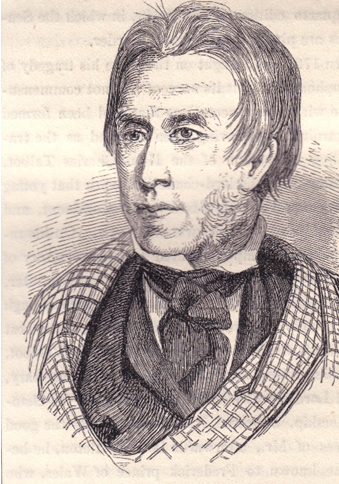|
THOM, JAMES, a
self-taught sculptor of great original genius, was born in Ayrshire in
1799. At first an obscure stone-cutter, without education or any
knowledge of the schools of art, he all at once became celebrated for a
group, the size of life, cut with great skill and perfect truth of
character, in the Scottish grey stone in which he had been accustomed to
work, representing “Tam O’ Shanter and Souter Johnny,” the exact
embodiment, in form, attitude, and expression, of the renowned
personages of Burns’ immortal poem, as conveyed in these lines:
------------“Ae market night,
Tam had got planted unco right,
Fast by an ingle, bleezing finely,
Wi’ reaming swats, that drank divinely;
And at his elbow Souter Johnny,
His ancient, trusty drowthy crony.”
This admirable group was
exhibited in Edinburgh in November 1828, and afterwards in several of
the other principal towns of Scotland. It was subsequently removed to
London, and secured for the humble but highly-gifted sculptor both fame
and employment, numerous orders for statues and busts being given to him
in the metropolis. With another group, “Old Mortality,” also in grey
stone, it was purchased by some speculators, who sent them with an agent
for exhibition in America. No returns being obtained from that person
nor any report of his proceedings, Mr. Thom himself was induced to leave
London about the year 1837, and sail to the United States in pursuit of
him. In this object he to some extent succeeded, and receiving
considerable encouragement to remain, he commenced the practice of his
profession at New York, joining to it that of a builder and architect.
He was favoured with numerous orders for copies of his far-famed groups,
besides being commissioned to chisel others, of a similar kind, and as
he was both frugal and industrious, he was enabled to save money. He
died at his lodgings in New York, of consumption, 17th April 1850, aged
51.
THOM, WILLIAM, one of the most natural of our minor poets, was
born in Aberdeen towards the close of 1799, or beginning of 1800. His
parents were in the humblest circumstances, and he was lame from his
birth. He lost his father at an early age, and his widowed mother was so
poor that she could not give him education and scarcely food. At the age
of ten, therefore, he was placed in a factory to earn his bread. After
four years’ apprenticeship, he entered the weaving establishment of
Messrs. Gordon, Barron & Co. in his native city, where he continued for
seventeen years. In the hope of bettering his condition, he then removed
to the village of Newtyle, Forfarshire, the inhabitants of which were at
that time, and to a great extent are yet, almost exclusively occupied as
weavers of linen fabrics, chiefly sheetings, for the manufacturers of
Dundee. In 1837, the failure of certain great commercial establishments
in America was the means of stopping upwards of 6,000 looms in Dundee
and the adjacent villages, and William Thom’s among the rest. The misery
and distress which ensued among the humble and dependent class of
weavers were very great. Thom and his family, for he was at this time
married, suffered the utmost privation and want. Houseless and
penniless, he was forced to wander through the country with them,
deriving his only subsistence from his flute. On one of these occasions,
while travelling, footsore, hungry, and weary, through Fife, he had the
added agony of his child dying from want, in an unsheltered outhouse.
Returning to Aberdeen, he was glad to find employment at the miserable
pittance of six shillings a-week. Thence he proceeded to Inverury, about
fifteen miles north-west of Aberdeen, where he obtained “customer work.”
For seven or eight months in the year he was enabled by weaving to earn
ten or twelve shillings a-week.
It was while he resided at Inverury that he
began to contribute some small poems to an Aberdeen paper. His
‘Mitherless Bairn,’ published in that local print, attracted the notice
of James Adam Gordon, Esq. of Knockespock, who immediately sent him five
pounds, and in 1841 invited him to visit him at an estate which he had
near Bristol. On his return to Scotland, Thom married a second wife, his
first having died in 1840. His poems were published in one volume in
1845. He died at Hawkhill, near Dundee, Feb. 28, 1848, leaving a widow
and three children, in great poverty. His portrait is subjoined.

[portrait of William Thom] |
